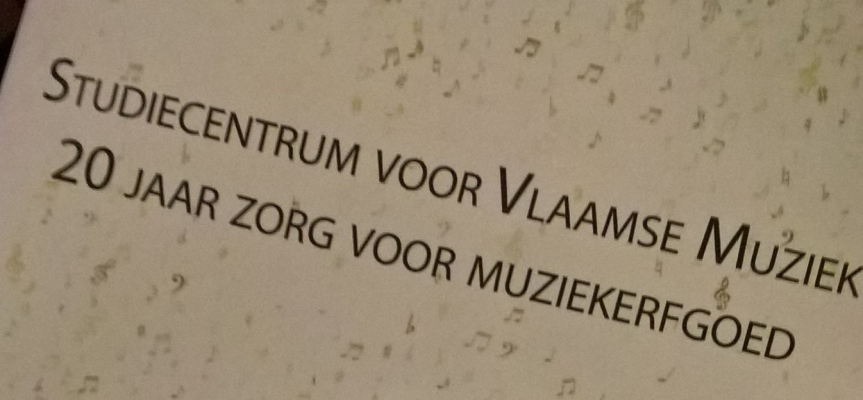Yesterday I gave a short talk at a Studienamiddag organised by the Study Centre for Flemish Music (Studiecentrum voor Vlaamse Musiek), with specific reference to some of the Belgian musicians and artists who were in Tunbridge Wells during the First World War. It was short and fairly superficial, but I thought I’d post it here for posterity, with some links.
There were a number of very interesting papers delivered, not least one by Jan Dewilde on Belgian women composers Eva Dell’Acqua and Maria Matthijssens which included a performance by Belgian soprano Eloise Mabille of two songs., “Villanelle” (dell’Acqua) and “Chaperon rouge” (Matthijssens).
My own presentation was followed by a performance of Frederic Bonzon’s “En Ardenne” by young oboist Balder Dendievel
Unfortunately I wasn’t able to stay for the evening concert. Had I done so I would have heard a performance of Peter Benoit’s Troisieme fantaisie, op. 18 which was played in a concert at the Club Albert in Tunbridge Wells on 1st January 1916 by Jef Denyn.
Frederic Bonzon (1850-1926) and the Royal Tunbridge Wells Belgian refugees, 1914-1919
Gooie namiddag, damens en herren….
It’s a great honour to be with you today to share in this 20th anniversary celebration and I thank Jan Dewilde for inviting me to speak. I must also thank him for his help in finding out more about Professor Bonzon when all I had was a scrap of music and an address.
But to start at the beginning –
As you will know only too well, during and after the terrible events of August 1914, something like a quarter of the population of Belgium fled, on foot, in carts, taking what they could carry, in many case with only the clothes they stood up in. Perhaps members of your own families were among them. I can’t imagine what it must have been like.
They fled to neutral Holland, to France and to the United Kingdom – 250,000 people – men women and children – made their way across the English Channel by whatever means possible, and in such numbers that in one week after the fall of Antwerp on 10th October 1914, 26,000 fugitives landed at Folkestone.
And among their number were 64 year old Professor Frederic Bonzon, his wife Marie Therese Faviesse and their grown-up daughter Marthe who arrived in Folkestone on 9th October 1914. We don’t know how they travelled, simply that they arrived and were soon in lodgings in the town.
Folkestone had become a veritable “town of refugees”. Many of those arriving were destitute, others were able to support themselves.
In early September the British Government had offered hospitality to any refugees from Belgium for as long as it was needed and soon a Central Refugees Committee was established in London followed by voluntary committees around the country. A scheme was put in place for receiving and registering the refugees.
On arrival in Folkestone, most people were sent to dispersal centres in London set up in public buildings like Alexandra Palace and Earls Court. The local committees around the country identified possible lodgings in their towns and villages and the refugees were then sent on to them.
Others went directly from Folkestone to the care of a local committee, and this was the case for the Bonzon family for in December 1914, just in time for Christmas, they are at a house in Tunbridge Wells – 11 Linden Park – a large 16-roomed house round the corner from the famous Pantiles. Unfortunately the house no longer exists. [1]
They shared the house with at least two families from Ostend – the Tanghe-Vanhercke-Groven family and the sister of painter James Ensor, her daughter and family and the painter’s friend and muse, Augusta Boogaerts and her nephew.
The house was one of those provided by the local refugees committee and had been lent rent-free by a local builder. The fact that the Bonzon family was given lodgings in one of the houses provided by the Committee suggests that they had left Antwerp with very little and were not able to support themselves.
The Tunbridge Wells committee had been set up by the Mayor in September/October 1914 and during the ensuing 4 1/2 years the committee looked after a total of 297 men, women and children, providing housing, clothing, and schooling, and often helping them find local employment. This number was augmented by those who were able to support themselves or stay with friends.
We learnt recently that one of the self-supporting families – the Meeus-Havenith family from Antwerp, chose to come to Tunbridge Wells simply because the novelist Thackeray had once lived there!
So what was the town the Bonzon family and others found themselves in, like?

Tunbridge Wells in 1914 was – a fashionable spa town,a royal municipal borough and market town, about 55 kms from London and about the same from Folkestone,with a population of about 36,000. It owed its existence to the discovery of its iron-rich spring water (similar to that in Spa here in Belgium) in the 17th century after which it became a favourite destination for royalty and fashionable society. In the 19th century the town began to attract more permanent residents. The surrounding countryside was ideal for walks and rides and early guide books of the town described the country houses that could be visited in the area.
But by the autumn of 1914 it had also become a military centre

with thousands of soldiers encamped in tents on the Common and billeted in empty houses in the town.
A notable feature of the town, was its religious-ness – it was predominantly Church of England and non-conformist, and well-known for its more Puritan tendencies. In 1914 there were 9 Anglican Churches, 9 non-Conformist chapels, a Quaker Meeting House and one Catholic church, St Augustine’s
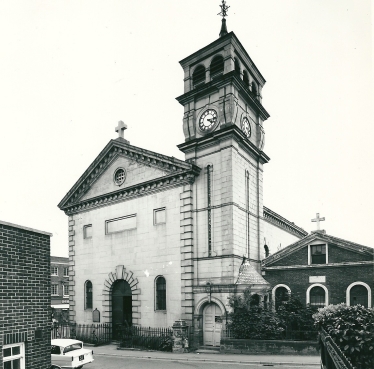
which became the spiritual home of the Belgian community, the scene of national celebrations such as the Belgian National Day and King’s Day, of marriages and baptisms, and sadly also of funerals.
A refugee priest from Mechelen, from SS Peter and Paul Church, Fr Louis Lemmens , ministered to the refugees until he left the town in mid-1915 when his place was taken by Fr Josef Peeters from Lint.
In November 1914 St Augustine’s was packed for the celebration of King’s Day, the traditional Te Deum was sung, led by a choir under the direction of one of the town’s refugees from Belgium – none other than the great Beiaardeer Josef Denyn who had arrived from Mechelen in October 1914 with his wife, their 6 children and his wife’s sister.
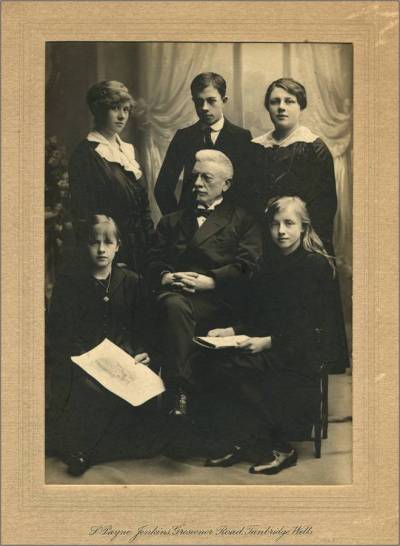
This photo of Jef Denyn and his family – for which I am most grateful to Koen Cosaert of the Koninklijke Beiaardschool in Mechelen – was probably taken some time in late 1917 as missing from it are Mr Denyn’s youngest daughter Emma and his wife Helene who tragically died during the family’s exile in Tunbridge Wells, in 1916 and 1917. Their graves are in the town’s cemetery. [2]
Tunbridge Wells already had a thriving musical life, with choral societies and orchestras, 2 or 3 theatres, and of course frequent concert parties & this continued throughout the war years, with performances not only by local musicians, professional & amateur, but also by visiting Belgian performers, often themselves refugees, such as Mme Helene Feltesse from the Brussels Opera and the violinist Eugene Ysaye. [In fact, Mr Isaye himself spent a few week in Tunbridge Wells in 1914 with his family (and their cook – and his Stradivarius. according to newspaper accounts) following their dramatic escape from Knokke in a fishing vessel.] And concert programmes in the town included music by Belgian composers such as Peter Benoit and Eva dell’Acqua whose “Villanelle” we will hear later I believe.
Unfortunately I have no found evidence of works by Profesor Bonzon being performed in Tunbridge Wells, nor of any performances given by him or his family – maybe simply because the oboe doesn’t lend itself to solo performance in the same way as piano, violin or voice.
In March 1915 Prof Bonzon was joined in Tunbridge Wells by his son Charles’s wife, Laure, and her 6 year old son Andre – they had been in Manchester, in the north of England – and in May 1915 Laure returned to Belgium, leaving her son with his grandparents and aunt. And the following year the family moved to apartments in a house nearer the centre of the town – just along from the Opera House.
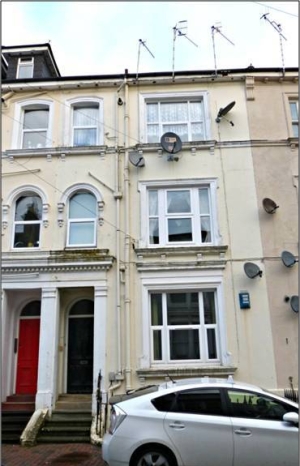
We have a photo of little Andre Bonzon with a group of Belgian children in the garden of a house in Tunbridge Wells.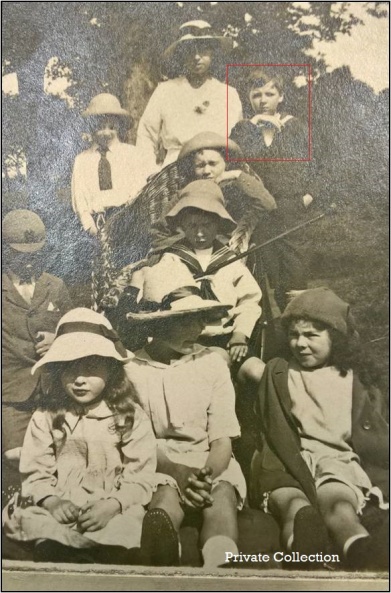 The photo belongs to the LIMPENS family, descendents of the MEEUS-HAVENITH family from Wynegem, whose grandparents are also in the photo – see the little boy in school uniform – probably Frederic MEEUS. Schooling was provided free of charge in local primary and secondary schools, but there was also a Belgian School in Tunbridge Wells, set up – probably in a private house – in early 1918 to provide instruction in French and Flemish to the children, alongside their English education.
The photo belongs to the LIMPENS family, descendents of the MEEUS-HAVENITH family from Wynegem, whose grandparents are also in the photo – see the little boy in school uniform – probably Frederic MEEUS. Schooling was provided free of charge in local primary and secondary schools, but there was also a Belgian School in Tunbridge Wells, set up – probably in a private house – in early 1918 to provide instruction in French and Flemish to the children, alongside their English education.
And while the children needed to continue their education, the adults wanted and were encouraged to work – though it was made clear not at the expense of local workers. Tunbridge Wells did not have the industry of other parts of the country, where the refugees were employed in munitions or aircraft factories for example, but there were certainly opportunities to work – as domestic staff in one of the big houses for example and Professor Bonzon’s daughter, Marthe, obtained a position as a Governess with the Talbot family in nearby Bidborough – possibly in response to this advertisement placed in the Kent and Sussex Courier of 7th May 1915 :

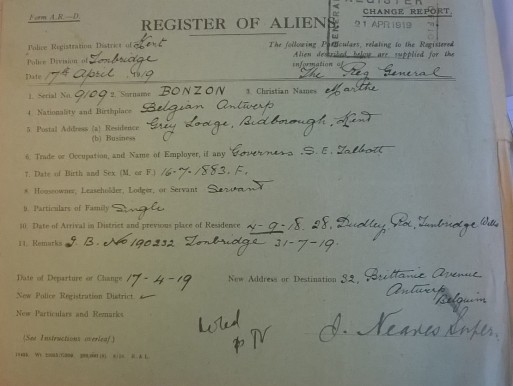
Marthe worked for them until she and her family returned to Antwerp in April 1919.
Going home was never far from the minds of the refugees, and finally after the Armistice in November 1918, this was possible – thought not until early 1919. The British government chartered ferries to provide free passage first to Antwerp and then also Ostend, The local committee in Tunbridge Wells reported that by May 1919 all the Belgian refugees had returned .
The Belgians had been in Tunbridge Wells for four and a half years and in that time were gradually absorbed into the life of the town. In the first year the newspapers were full of stories and reports of Belgian National Day and King’s Day and social events held at the Belgian social club, the Club Albert.
Their presence now is hardly known about, but they did leave at least two memorials of their stay.

The first is an almost life-size bust of the then Mayor, Mr Whitbourn Emson, who was chair of the refugees committee during the whole period.
It was commissioned and paid for by the Belgian Community from sculptor Paul Van Den Kerckhove, himself a refugee who stayed in the town with his wife and two daughters, and it stands today in the lobby to the Council Chamber in Tunbridge Wells Town Hall.
The other “memorial” is much smaller but perhaps more important – certainly from a researcher’s point of view –
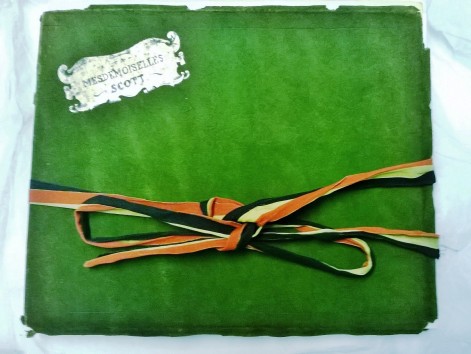 and that is a souvenir album signed by some 180 Belgians and presented to two Tunbridge Wells sisters, Amelia and Louisa Scott, who both worked tirelessly to help the refugees from Belgium.
and that is a souvenir album signed by some 180 Belgians and presented to two Tunbridge Wells sisters, Amelia and Louisa Scott, who both worked tirelessly to help the refugees from Belgium.
Indeed Amelia Scott was awarded the Golden Palms of the Order of the Crown by the King of the Belgians for her work.
But the souvenir album was a very special thank you from the people she helped, and it was there that I came across this :
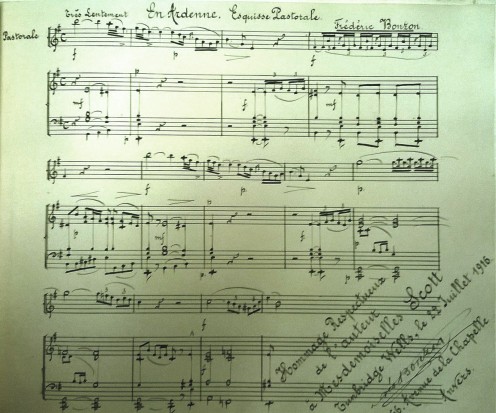
Professor Bonzon’s Oboe piece – En Ardennes – alongside which he wrote Hommage respectueux de l’auteur a Mesdemoiselles Scott Tunbridge Wells le 22 juillet 1916…
…And this seems a fitting place to stop as the moment has arrived for you to hear that very piece of music.
Thank you again for inviting me to speak today. And please don’t hesitate to talk to me or contact me later if you would like to know more, or indeed if you yourselves can add to our research. [3]
Thank you.
[1] This morning I found this fascinating blog post by Ed Gilbert about 10 Linden Park – maybe number 11 was similar?
[2] See earlier blog The refugees who never went home
[3] Afterwards I spoke to a gentleman who believes a member of his family married one of Jef Denyn’s daughters (and will let me know), and to Koen Cosaert, Director of the ‘Jef Denyn’ Beiaardschool in Mechelen, who told me that in letters held in their archives Jef Denyn wrote that the family chose Tunbridge Wells as it was cheaper than London! I also discussed with Mr Cosaert the possibility of a Carillon piece by W.W. Starmer’s being played in Mechelen in June 2019 – fingers crossed…

